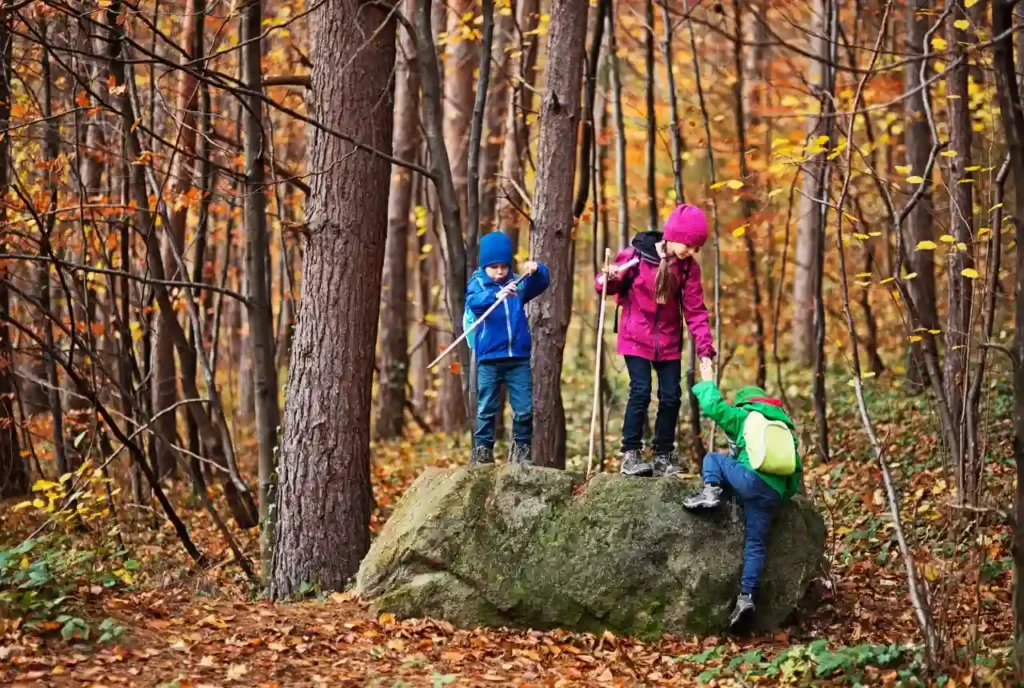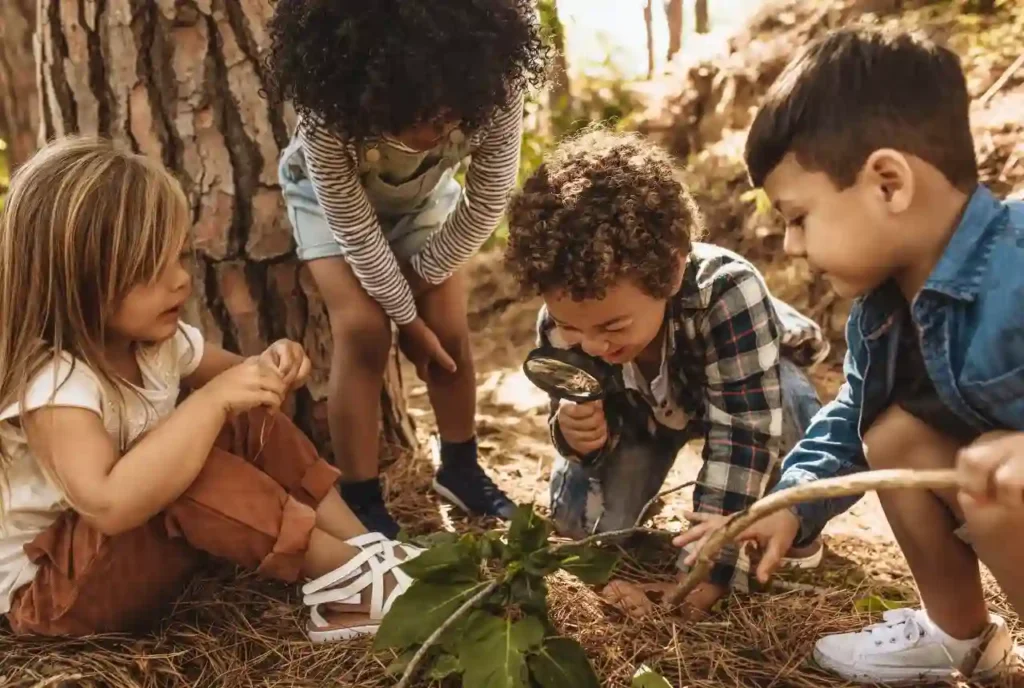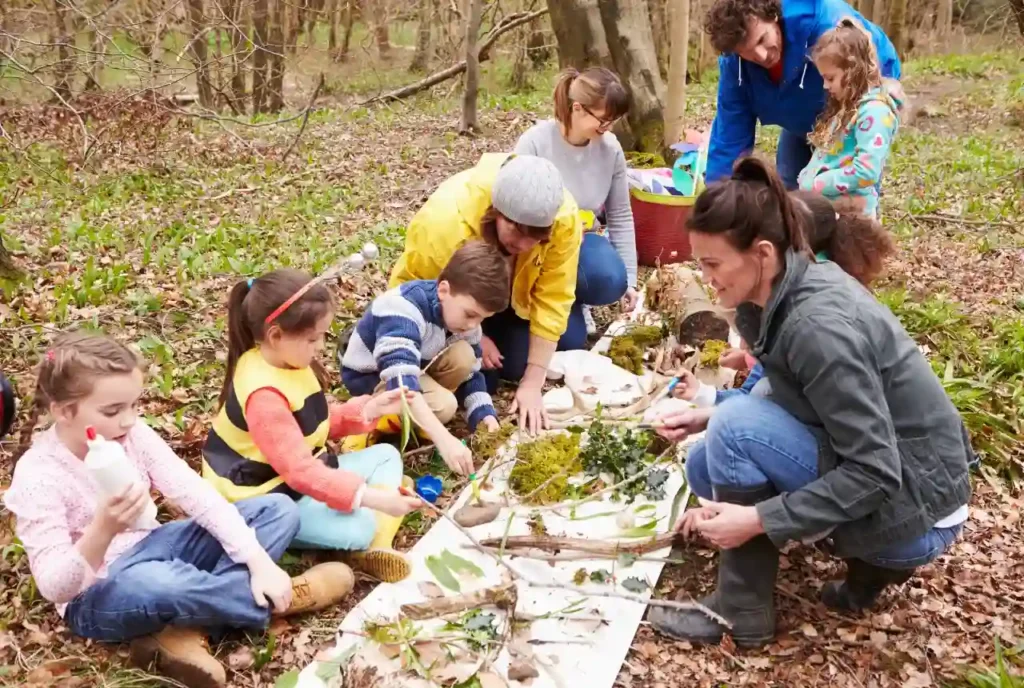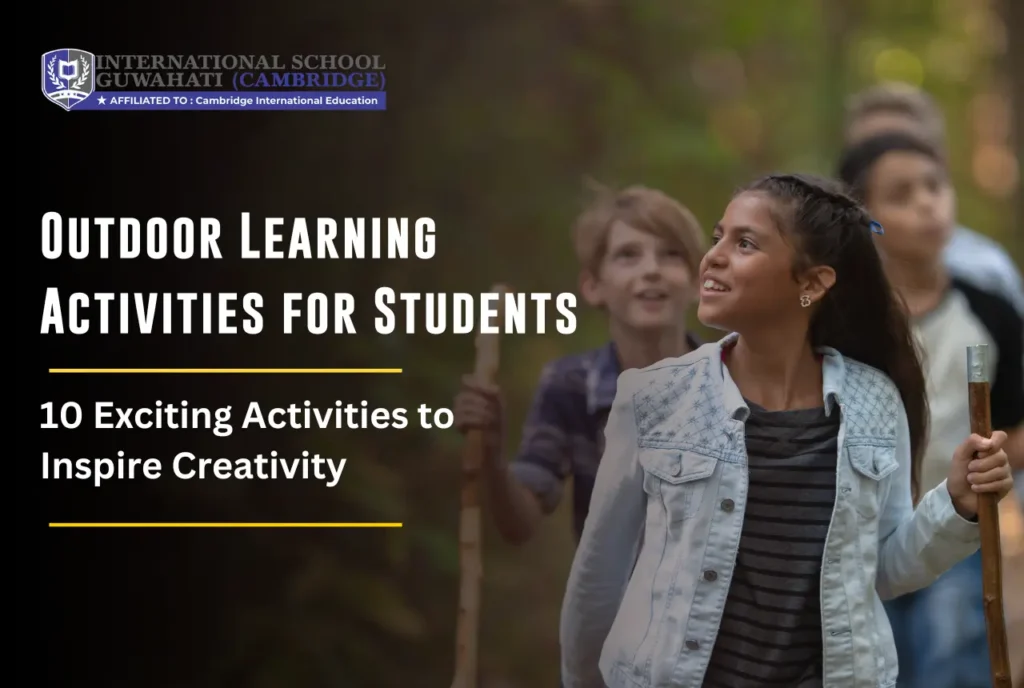![]()
Outdoor learning activities for students offer numerous benefits, including improved academics, creativity, social skills, and health. Studies demonstrate that learning outside in natural settings can enhance thinking skills and help kids focus better, fostering a sense of curiosity and eagerness to explore, which is essential for their overall growth.
Incorporating outdoor learning activities into school lessons is crucial because it provides a more comprehensive education by breaking up the routine of sitting in a classroom and illustrating how concepts learned in class apply to real-life situations.
Outdoor learning helps students apply what they have learned in new ways, leading to better understanding and retention. Creativity is also vital for students, as it enables them to solve problems in innovative ways and think of diverse ideas.
This article explores ten engaging outdoor activities that can help kids be more creative and develop a deeper interest in learning.
These activities, such as a Nature Scavenger Hunt, Sensory Nature Walk, Outdoor Art Project, Nature Journaling, and Building with Natural Materials, not only encourage creativity but also teach teamwork, environmental awareness, and problem-solving skills.
10 Exciting Outdoor Learning Activities for Students to Inspire Creativity
Nature Scavenger Hunt

Exploring the outdoors with a nature scavenger hunt! It’s a fun activity where kids search for natural treasures like leaves of different shapes, butterflies, beetles, and colorful rocks. It helps them learn about nature, observe closely, and appreciate biodiversity. It’s designed for all ages and learning goals, making it an exciting adventure for everyone!
Sensory Nature Walk
Take a sensory nature walk and use all five senses to explore the outdoors! Look for something soft to touch, smell something sweet, and listen for bird calls. This hands-on activity boosts sensory awareness, deepens the connection to nature, and sparks curiosity, making learning both fun and interactive.
Outdoor Art Project

Create art with nature by using natural materials for outdoor art projects. Students can gather leaves, sticks, stones, and flowers to make various artworks. Imagine vibrant leaf collages with different shapes and colors, imaginative 3D sculptures from sticks and stones, and symmetrical nature mandalas arranged on the ground.
These activities spark creativity and teach about the natural world, promoting environmental awareness. Engaging with nature in this artistic way enhances mindfulness and fosters a deeper connection to the environment, making learning both fun and meaningful.
Dramatic Play in Nature
Dramatic play in nature lets students act out stories or scenarios outdoors. They can reenact a scene from a nature-themed book or pretend to be animals in their habitat. This activity boosts creativity, social skills, and understanding of natural environments through imaginative role-play.
Sun-Printing
Sun-printing is a fun and educational outdoor activity where students use sunlight to make unique prints on paper. To do this, place natural objects like leaves, flowers, or small branches on light-sensitive paper. When exposed to sunlight, the paper changes color except where the objects block the light, leaving detailed silhouettes.
After a few minutes in the sun, rinse the paper in water to reveal the final print. This combines art with basic photography and chemistry principles, teaching students about light sensitivity and shadow effects while sparking creativity and exploration of natural materials.
Building with Natural Materials
Building with natural materials like sticks, leaves, and rocks sparks creativity and problem-solving skills in students. This hands-on activity promotes teamwork and spatial awareness. They can construct forts for imaginative play, fairy houses for storytelling, and small bridges to learn basic engineering. These projects not only boost creativity but also deepen students’ connection to nature, making learning both interactive and engaging.
Outdoor Math Games
Outdoor spaces can be fun learning environments for math concepts. Students can estimate distances by pacing, measure objects using natural materials like sticks or leaves, and create symmetrical patterns with found objects. These activities reinforce math skills, encourage exploration, and foster problem-solving in a natural setting. By integrating math with outdoor play, students develop a deeper understanding of mathematical concepts while enjoying the benefits of being outdoors.
Nature Journaling

Nature journaling encourages observation skills and creativity by recording details of the natural world. Students can include drawings and descriptions of plants and animals, along with reflections on the sounds and smells of nature. This practice fosters a deeper connection to the environment and promotes mindfulness through reflective writing.
Outdoor Story Writing
Outdoor environments inspire creative writing by immersing students in nature. Prompts include writing a story from an animal’s perspective or creating a narrative based on a natural object found outdoors. This activity enhances storytelling skills, imagination, and appreciation for the natural world, making learning interactive and enjoyable.
Citizen Science Projects
Citizen science projects engage students in real-world scientific research through outdoor activities. They can contribute by birdwatching to track bird populations, identifying trees to monitor biodiversity, or testing water quality to assess environmental health. These activities empower students to make meaningful contributions to scientific knowledge and foster environmental stewardship.
Benefits of Outdoor Learning Activities for Students

Benefits of Outdoor Learning Activities for Students
Outdoor learning activities offer numerous benefits for students, enhancing their educational experience and fostering personal growth. These activities not only inspire creativity but also promote critical thinking, problem-solving skills, imagination, and resourcefulness.
Enhanced Critical Thinking and Problem-Solving Skills
Outdoor learning challenges students to solve problems in real-world contexts. For example, building structures with natural materials like sticks and rocks requires planning and problem-solving as students figure out how to stabilize their constructions. Research has shown that outdoor learning improves students’ ability to think critically and creatively when faced with challenges (Blair, 2009).
Development of Imagination and Resourcefulness
Outdoor environments stimulate imagination and resourcefulness. When children engage in imaginative play outdoors, they create scenarios and stories based on their surroundings. For instance, pretending to be animals in their natural habitat or inventing games with found objects encourages creativity and innovation (Fjørtoft, 2001). This type of play nurtures imaginative thinking and the ability to think outside the box.
Increased Exposure to New Experiences and Ideas
Outdoor learning exposes students to a wide range of new experiences and ideas. Exploring natural environments allows them to observe and interact with different plants, animals, and landscapes. This exposure stimulates curiosity and a sense of wonder, which are essential for learning and personal development (Chawla, 2015). Students also learn about ecosystems, weather patterns, and the environment, fostering a deeper appreciation for the natural world.
Tips for Implementing Outdoor Learning Activities

Implementing outdoor learning activities effectively requires careful planning and considering various factors to ensure a safe and enriching experience for students. Here are some practical tips for teachers, parents, or educators:
Choose Activities and Goals for the Students’ Age
Pick activities that match the students’ age and what they’re learning. Make sure the goals of the activities match what they’re learning in class and let them explore outside.
Make Sure the Students are Safe and Watched
Think about the safety of the place where they will be learning outside. Have an adult there to help the students and keep them safe from things that could hurt them.
Make Sure the Students Dress Right for the Weather
Make sure the students wear the right clothes for the weather, like hats or sunscreen. Be ready if the weather changes, like having coats or more clothes to keep them warm or dry.
Use the Things Outside to Help the Students Learn
Use natural things outside, like trees or rocks, to help the students learn. Using these things can make the activities more fun and help them learn more.
Use Outdoor Activities with What They Learn in Class
Use what they learn in class to help them learn outside, too. For example, they can learn about plants on a walk or use art to talk about things they read in books.
By following these tips, teachers and parents can make learning outside fun and help the students learn more and be more connected with nature.
Conclusion
Research indicates that children who participate in outdoor learning activities demonstrate improved academic performance, increased motivation to learn, and higher levels of engagement in their studies (Kuo et al., 2018). Moreover, spending time outdoors has been linked to reduced stress levels and improved overall well-being.
Outdoor learning is vital for nurturing creativity in students through exploration, discovery, and hands-on experiences in nature. These activities ignite imagination, problem-solving skills, and critical thinking, enriching academic learning and personal growth. Educators should incorporate outdoor learning to enhance educational experiences and foster a stronger bond with nature. Additional resources for outdoor learning activities are available on educational websites, in nature centers, and through outdoor education programs, offering ample support for implementing effective outdoor learning experiences. Embracing outdoor learning can cultivate a lifelong passion for learning and a profound appreciation for our natural world.










